Olafur Eliasson filters the natural world through new technologies, using intangible elements such as smoke, light and wind as his materials in his sculptures and installations. Having been greatly influenced by the work of Robert Irwin, Eliasson considers his overriding concern to be an awareness of the act of perception. However, by introducing elements such as temperature and humidity, as well as a more overt disruption of physical orientation, he goes even further to show how not only the eye, but also the rest of the body, responds to various stimuli — in addition to the emotional and intellectual reactions one might have when anticipating, discovering and experiencing a new or altered situation. Eliasson's work often involves an intervention which either takes its cue from its surroundings or imposes upon them constructions that affect them in some way. His installations may incorporate some or all of the properties of reflected or projected light, color, geometry, movement, water, wind, sound and temperature. He uses natural and industrial materials, as well as the environments of nature and architecture, to create situations that, while not esthetically displeasing and often very compelling, are less about their look than about the experience they create for the viewers, who, by their very presence, become integral elements in the work. Over the past fifteen years Eliasson has built up an impressive body of work consisting of rainbows, sunsets, waterfalls, scent walls, fog, mist, beams of light and periscopes. His stunning installations encompass his audience in a world that is at odds with standard physics.
Lava Floor (2002)
Eliasson's work was an installation lava rock on the floor of the lobby of the exhibition space. Visitors were invited to walk across the uneven surface to reach the galleries. Eliasson often attempts to bring nature into the exhibition space in such a way that makes the visitor physically engage.
Your Strange Certainty Still Kept
In a dark and silent room drops of falling water are lit by the rhythmic flashing of strobe lights, creating the effect that gravity has been suspended.
Beauty (1993)
From the exhibition Take your time: Olafur Eliasson, installation view at San Francisco Museum of Modern Art
Gently falling mist from the overhead sprinklers produce iridescent effects as the light is diffracted on the tiny droplets of water as it descends. Other than the light and the mist the room is empty.
In Beauty, transformation makes the work successful. Water is allowed to do what it does naturally, but in the process becomes something much more rich and complex than expected. Eliasson reveals water's unique optical properties, transcending the materials that are used to make the work.
Notion Motion (2005)
From the exhibition Take your time: Olafur Eliasson, installation view at San Francisco Museum of Modern Art
Notion motion consists of three installations that explore the interaction between water, light and the viewer - an installation of ripples of water reflected in light, in which Eliasson visualizes light waves. Notion Motion is an enchanting work created with simple means. Eliasson immerses the viewer in a simple and minimal yet overwhelming visual experience created by the interplay of light and water.
At the end of a long hallway is a large screen with ripples floating upwards. Some of the wooden floorboards are higher than the others, and as you step on them you realize they might bear some relation to what you see on the screen, but it is difficult to make the connection. The waves on the screen do appear more active after stepping on a plank, but there is variation and a definite time delay.
After another short hallway and around the corner, you enter another room where you get to see behind the screen. The floor boards in the previous rooms control a set of paddles in a shallow pool. Light is reflected off the surface of the water which is displayed on the screen.
It is interesting that although you can see how the mechanism works in this room, you are a passive observer. It creates an interesting duality between artist and observer, because the first room, when you pressed the floor boards, you were creating the work but in the second room when you finally have some sort of understanding you can only act as an observer. Eliasson only sets up the conditions to allow you to have that experience but you have to create the art yourself. It raises interesting questions about where is the art - in the artist or the observer? The piece sums up many of the ideas explored throughout Eliasson's work.
One of the most brilliant aspects of Eliasson’s work comes not only from his knowledge of perception and sensory experience, but also from his use of materials and special effects that generate universal responses. Take Your Time is fascinating on many levels, namely because it is successful whether you view it in solitude or experience it with a group of people. Neither circumstance diminishes the other, both acts, communal and individual, become equally important.
Reversed Waterfall
Eliasson's contraption attempts to reverse gravity — the most paradigmatic of physical laws. Yet it does so fully within the realm of the physical and the visible.
Moss Wall (1994)
The Forked Forest Path (1998)
Saplings (such as silver birch) are woven together to create the powerful illusion of a dense forest in this installation.
The Weather Project, Tate Modern Turbine Hall
The Weather Project consists of a huge, yellow, artificial indoor sun. The distant ceiling is mirrored, and viewers can see their small, shadowy, inverted reflections through the mist.
Eliasson toys with ideas of the sublime and technology, careful to make us aware of the mechanics of his work - that what he has done is a trick, a thing of smoke and mirrors, and an 18,000-watt bank of sodium yellow streetlight bulbs. You can walk under the sun, see behind the backlit screen, and watch the weather wafting from the smoke generators.
Eliasson used hundreds of monochromatic lamps which radiated single frequency yellow light to create a semi-circular disc, and humidifiers to create a fine mist in the air via a mixture of sugar and water. Throughout the day, the mist accumulates into faint cloud-like formations before dissipating across the space. The ceiling of the hall was covered with huge mirrors, in which visitors could see themselves as tiny black shadows against a mass of orange light. Many visitors responded to this exhibition by lying on their backs and waving their hands and legs. Open for six months, the work reportedly attracted two million visitors, many of whom were repeat visitors.
Eliasson wants us to consider why we talk about the weather so much, and how weather impinges on our culture and our sense of ourselves. The installation explores ideas of experience, mediation and representation.
The Mediated Motion at the Kunsthaus Bregenz in Austria (2001)
Eliasson created a sequence of spaces filled with natural materials including water, fog, earth, wood, fungus and duckweed. During their journey through the exhibition, visitors were confronted by a variety of sensory experiences – sights, smells, and textures – which had been precisely articulated by the artist. Eliasson also modified the building, including the insertion of a subtly slanting floor which made visitors become more conscious of the act of movement through space.

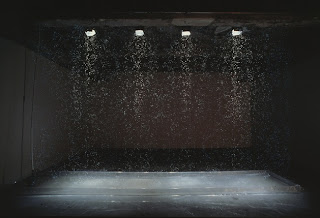

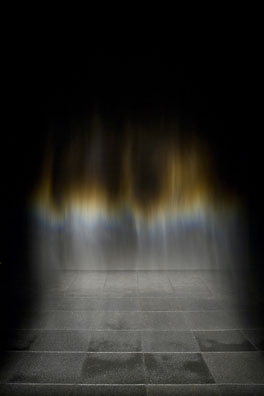

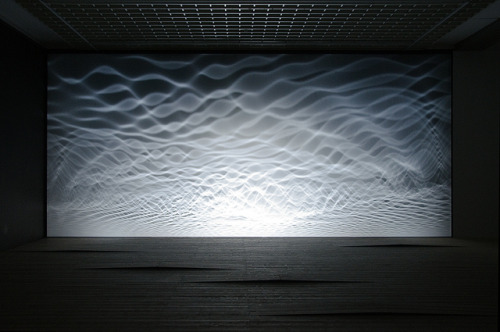












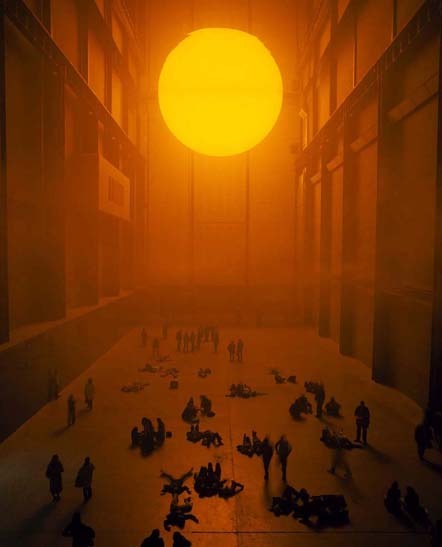



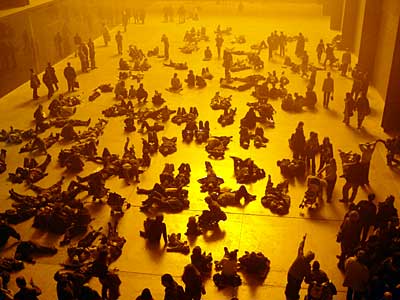



No comments:
Post a Comment